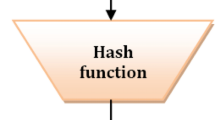Abstract
IoT in Wireless Sensor Networkis a network of physical objects connected to internet such as RFID and sensors. As these types of objects have limited computation power and memory, execution of public key cryptography would be a daunting task. So a light weight encryption with Elliptic Curve Cryptography (ECC) is proposed in this work. A major issue in ECC is its computational cost as it is complicated to compute the scalar multiplication. To address this issue, a novel method called graph based addition chaining (GBAC) is proposed. This graph technique produces all possible optimum addition chains for the given integer n by utilizing edge weight of all possible numbers created from each number of addition chain. This addition chain technique can be used in modular exponentiation which is an essential step in the implementation of public cryptographic algorithms like ElGamal, RSA, etc., so that the time for encryption and decryption for these algorithms can be reduced drastically. The proposed GBAC technique has used addition chaining technique instead of scalar multiplication in ECC which greatly reduces the computation time as well as computation cost. It also reduces the complexity in ECC. Numerous experiments has been made and proved that our work decreases the decryption time by at least 10% than RSA algorithm, reduces computation cost and improves the performance of parameters like CPU time, Memory requirement and key preparation time and better than RSA in decryption.
















Similar content being viewed by others
References
Kapadnis, S. (2014). Hierarchical attribute based encryption in cloud environment. International Journal of Computer Applications—Innovations and Trends in Computer and Communication Engineering,1, 17–20.
Krishna, N., & Bhavani, L. (2013). HASBE: A hierarchical attribute set based encryption for flexible, scalable and fine grained access control in cloud computing. International Journal of Computer & Organization Trends,3(5), 294–301.
Wang, G., Liu, Q., Jie, W., & Guo, M. (2011). Hierarchical attribute-based encryption and scalable user revocation for sharing data in cloud servers. Journal of Computers and Security,30(5), 320–331.
Sreelesh, N. K., & Santhosh, K. B. J. (2018). An advanced hierarchical attribute based encryption access control in mobile cloud computing. International Journal of Engineering & Technology,7, 18–22.
Mahto, D., Khan, D. A., & Yadav, D. K. (2016). Security analysis of elliptic curve cryptography and RSA. The World Congress on Engineering, 1.
Rajam, S. T. R., & Kumar, S. B. R. (2015). Enhanced elliptic curve cryptography. Indian Journal of Science and Technology. https://doi.org/10.17485/ijst/2015/v8i26/80444.
Boahen, E. K., & Ben, J. (2018). An enhanced elliptic curve cryptosystem for securing data. International Journal of Computer Applications,182(9), 47–53. https://doi.org/10.5120/ijca2018917688.
Keerthi, K., & Surendiran, B. (2017). Elliptic curve cryptography for secured text encryption. In International conference on circuits power and computing technologies [ICCPCT] https://doi.org/10.1109/iccpct.2017.8074210.
Herbaut, F., & Véron, P. (2010). A public key cryptosystem based upon euclidean addition chains. In International conference on sequences and their applications (pp. 284–297) https://doi.org/10.1007/978-3-642-15874-2_24.
Proy, J., Veyrat-Charvillon, N., Tisserand, A., & Méloni, N. (2015). Full hardware implementation of short addition chains recoding for ECC scalar multiplication. In Compas’2015: Parallélisme/Architecture/Système Lille.
Picek, S., Coello, C. A. C., Jakobovic, D., & Mentens, N. (2016). Evolutionary algorithms for finding short addition chains: Going the distance. In Deconstructing the big valley search space hypothesis, at springer, Volume: Lecture notes in computer science 9595 (pp. 121–137). https://doi.org/10.1007/978-3-319-30698-8_9.
Leinweber, L., Papachristou, Ch., & Wolff, F. G. (2012). An efficient elliptic curve cryptography processor using addition chains with high information entrophy. In Canadian conference on electrical and computer engineering https://doi.org/10.1109/ccece.2012.6334841.
Liu, H., Zhou, Y., & Zhu, N. (2013). A novel elliptic curve scalar multiplication algorithm against power analysis. Mathematical Problems in Engineering. https://doi.org/10.1155/2013/862508.
Giorgi, P., Imbert, L., & Izard, T. (2009). Optimizing elliptic curve scalar multiplication for small scalars. In Proceedings of SPIE—The international society for optical engineering (Vol. 7444) https://doi.org/10.1117/12.827689.
Le, D.-P., & Tan, C. H. (2011). Improved precomputation scheme for scalar multiplication on elliptic curves. In IMA international conference on cryptography and coding (pp. 327–343) https://doi.org/10.1007/978-3-642-25516-8_20.
Stergiou, C., Psannis, K. E., Gupta, B. B., & Ishibashi, Y. (2018). Security, privacy & efficiency of sustainable cloud computing for big data & IoT. Sustainable Computing: Informatics and Systems,19, 174–184. https://doi.org/10.1016/j.suscom.2018.06.003.
Plageras, A. P., Psannis, K. E., Stergiou, C., Wang, H., & Gupta, B. B. (2018). Efficient sensor BIG data collection processing and analysis in smart buildings. Future Generation Computer Systems,82, 349–357. https://doi.org/10.1016/j.future.2017.09.082.
Stergiou, C., Psannis, K. E., Kim, B.-G., & Gupta, B. (2018). Secure integration of IoT and cloud computing. Future Generation Computer Systems,78(3), 964–975. https://doi.org/10.1016/j.future.2016.11.031.
Roy, D. B., & Mukhopadhyay, D. (2019). High-speed implementation of ECC scalar multiplication in GF(p) for generic montgomery curves. IEEE Transactions on Very Large Scale Integration (VLSI) Systems,27(7), 1587–1600.
Ding, S., Li, C., & Li, H. (2018). A novel efficient pairing-free CP-ABE based on elliptic curve cryptography for IoT. IEEE Access,6, 27336–27345.
Bos, J. W., & Friedberger, S. J. (2019). Arithmetic considerations for isogeny-based cryptography. IEEE Transactions on Computers,68(7), 979–990.
Mani, K., & Viswambari, M. (2017). A new method of generating optimal addition chain based on graph. International Journal of Mathematical Sciences and Computing,2, 37–54. https://doi.org/10.5815/ijmsc.2017.02.04.
Shahroodi, T., Bayat-Sarmadi, S., & Mosanaei-Boorani, H. (2019). Low-latency double point multiplication architecture using differential addition chain over GF(2m). IEEE Transactions on Circuits and Systems I: Regular Papers,66(4), 1465–1473.
Li, L., & Li, S. (2018). High-performance pipelined architecture of point multiplication on Koblitz curves. IEEE Transactions on Circuits and Systems II: Express Briefs,65(11), 1723–1727.
Guerrini, E., Imbert, L., & Winterhalter, T. (2018). Randomized mixed-radix scalar multiplication. IEEE Transactions on Computers,67(3), 418–431.
Author information
Authors and Affiliations
Corresponding author
Additional information
Publisher's Note
Springer Nature remains neutral with regard to jurisdictional claims in published maps and institutional affiliations.
Rights and permissions
About this article
Cite this article
Jayaram, A., Deb, S. A Hybrid Addition Chaining Based Light Weight Security Mechanism for Enhancing Quality of Service in IoT. Wireless Pers Commun 113, 1073–1095 (2020). https://doi.org/10.1007/s11277-020-07268-4
Published:
Issue Date:
DOI: https://doi.org/10.1007/s11277-020-07268-4




